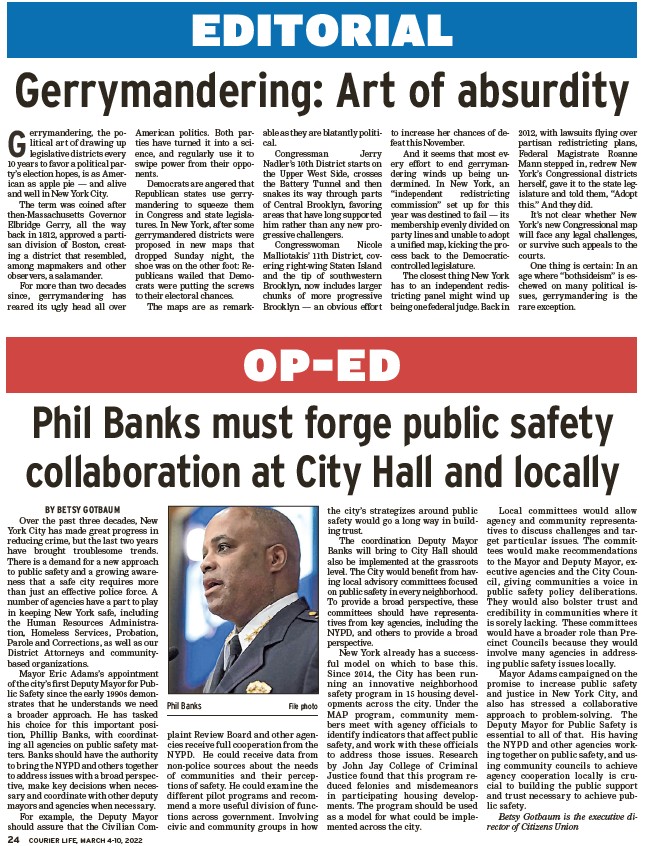
Gerrymandering: Art of absurdity
Phil Banks must forge public safety
collaboration at City Hall and locally
COURIER L 24 IFE, MARCH 4-10, 2022
EDITORIAL
OP-ED
Gerrymandering, the political
art of drawing up
legislative districts every
10 years to favor a political party’s
election hopes, is as American
as apple pie — and alive
and well in New York City.
The term was coined after
then-Massachusetts Governor
Elbridge Gerry, all the way
back in 1812, approved a partisan
division of Boston, creating
a district that resembled,
among mapmakers and other
observers, a salamander.
For more than two decades
since, gerrymandering has
reared its ugly head all over
American politics. Both parties
have turned it into a science,
and regularly use it to
swipe power from their opponents.
Democrats are angered that
Republican states use gerrymandering
to squeeze them
in Congress and state legislatures.
In New York, after some
gerrymandered districts were
proposed in new maps that
dropped Sunday night, the
shoe was on the other foot: Republicans
wailed that Democrats
were putting the screws
to their electoral chances.
The maps are as remarkable
as they are blatantly political.
Congressman Jerry
Nadler’s 10th District starts on
the Upper West Side, crosses
the Battery Tunnel and then
snakes its way through parts
of Central Brooklyn, favoring
areas that have long supported
him rather than any new progressive
challengers.
Congresswoman Nicole
Malliotakis’ 11th District, covering
right-wing Staten Island
and the tip of southwestern
Brooklyn, now includes larger
chunks of more progressive
Brooklyn — an obvious effort
to increase her chances of defeat
this November.
And it seems that most every
effort to end gerrymandering
winds up being undermined.
In New York, an
“independent redistricting
commission” set up for this
year was destined to fail — its
membership evenly divided on
party lines and unable to adopt
a unifi ed map, kicking the process
back to the Democraticcontrolled
legislature.
The closest thing New York
has to an independent redistricting
panel might wind up
being one federal judge. Back in
2012, with lawsuits fl ying over
partisan redistricting plans,
Federal Magistrate Roanne
Mann stepped in, redrew New
York’s Congressional districts
herself, gave it to the state legislature
and told them, “Adopt
this.” And they did.
It’s not clear whether New
York’s new Congressional map
will face any legal challenges,
or survive such appeals to the
courts.
One thing is certain: In an
age where “bothsideism” is eschewed
on many political issues,
gerrymandering is the
rare exception.
BY BETSY GOTBAUM
Over the past three decades, New
York City has made great progress in
reducing crime, but the last two years
have brought troublesome trends.
There is a demand for a new approach
to public safety and a growing awareness
that a safe city requires more
than just an effective police force. A
number of agencies have a part to play
in keeping New York safe, including
the Human Resources Administration,
Homeless Services, Probation,
Parole and Corrections, as well as our
District Attorneys and communitybased
organizations.
Mayor Eric Adams’s appointment
of the city’s fi rst Deputy Mayor for Public
Safety since the early 1990s demonstrates
that he understands we need
a broader approach. He has tasked
his choice for this important position,
Phillip Banks, with coordinating
all agencies on public safety matters.
Banks should have the authority
to bring the NYPD and others together
to address issues with a broad perspective,
make key decisions when necessary
and coordinate with other deputy
mayors and agencies when necessary.
For example, the Deputy Mayor
should assure that the Civilian Complaint
Review Board and other agencies
receive full cooperation from the
NYPD. He could receive data from
non-police sources about the needs
of communities and their perceptions
of safety. He could examine the
different pilot programs and recommend
a more useful division of functions
across government. Involving
civic and community groups in how
the city’s strategizes around public
safety would go a long way in building
trust.
The coordination Deputy Mayor
Banks will bring to City Hall should
also be implemented at the grassroots
level. The City would benefi t from having
local advisory committees focused
on public safety in every neighborhood.
To provide a broad perspective, these
committees should have representatives
from key agencies, including the
NYPD, and others to provide a broad
perspective.
New York already has a successful
model on which to base this.
Since 2014, the City has been running
an innovative neighborhood
safety program in 15 housing developments
across the city. Under the
MAP program, community members
meet with agency officials to
identify indicators that affect public
safety, and work with these officials
to address those issues. Research
by John Jay College of Criminal
Justice found that this program reduced
felonies and misdemeanors
in participating housing developments.
The program should be used
as a model for what could be implemented
across the city.
Local committees would allow
agency and community representatives
to discuss challenges and target
particular issues. The committees
would make recommendations
to the Mayor and Deputy Mayor, executive
agencies and the City Council,
giving communities a voice in
public safety policy deliberations.
They would also bolster trust and
credibility in communities where it
is sorely lacking. These committees
would have a broader role than Precinct
Councils because they would
involve many agencies in addressing
public safety issues locally.
Mayor Adams campaigned on the
promise to increase public safety
and justice in New York City, and
also has stressed a collaborative
approach to problem-solving. The
Deputy Mayor for Public Safety is
essential to all of that. His having
the NYPD and other agencies working
together on public safety, and using
community councils to achieve
agency cooperation locally is crucial
to building the public support
and trust necessary to achieve public
safety.
Betsy Gotbaum is the executive director
of Citizens Union
Phil Banks File photo